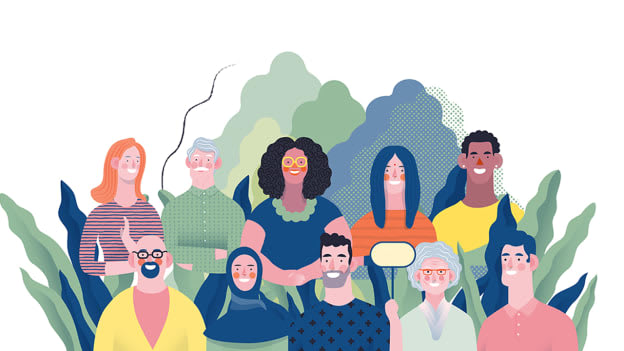Adopting design thinking to reimagine employee experience

Design thinking has come to become the dominant approach of designing clever new products and differentiated customer experiences. From its roots in industrial and product design and architecture, the method of design thinking is finding applications in solving technical and behavioral problems in an array of scenarios, in both business to business and business to consumer settings. Thanks to Jeff Bezos and his relentless pursuit of customer obsession, the notion of “customer centricity” has come to mainstream ethos of running organizations. What Steve Jobs brought to design, Taiichi Ohno brought to quality, and Andy Grove lend to operations, Jeff Bezos infused in customer service: passion with purpose. However, a customer centric organization has to be foremost an employee centric organization, or else how would your front-end, customer facing employees go far and beyond the “script” to delight your customers with memorable experiences. And why only the customer facing executives, the entire organization must rally around the “True North”.
In this article, I discuss about how the human resources professionals can adopt the tenets of design thinking to craft differentiated and enduring employee experiences, and why the truest pursuit of customer obsession is always routed through employee obsessions. The call for thinking differently towards employee engagement has taken alarming proportions owing to the COVID-19 induced lockdown and ensuing economic and social slowdown, which has pushed scores of employees to adopt sub-optimal ways of working and spending time with their families and self. This has led to wide-felt and deep-rooted stress and disengagement and unless addressed creatively and urgently this disenchantment can lead to irreversible loss of employee morale and deterioration of organizational culture.
Waiting for things to return to normal might be a tunnel dream, for even while employees work from home or are in office for limited durations, their engagement levels are sloping downwards.
Drawing from the practice of design thinking, I offer three recommendations on how people managers, from across functions and the organizational hierarchy, can re-energize, re-engage, and re-invigorate their dispersed employee base in time.
Engage with the 'human' in your employee
Design thinking starts with “empathy” - being the person you wish to help. As a practicing manager, you would appreciate that empathy does not come easy or cheap. It requires a tremendous amount of patience and practice - to be able to understand one’s emotional state, getting to control the emotions in self, graduating to understand others’ emotional motivations, and then being able to influence those. Emotional intelligence, says Daniel Goleman, is one of the life’s most crucial skills and he rates it above IQ.
Microsoft CEO, Satya Nadella, identifies empathy as core to business. In his book, Hit Refresh, Satya narrates an incident from his interview at Microsoft when he was asked the question, “Imagine you see a baby laying in the street, and the baby is crying. What would you do?” Satya, all in his 20s, said, “You call 911.” Years later, when Satya reflects on his callous response, he wonders how apathetic he was and the way his life’s experiences, especially the birth of his son, Zain, who suffered from cerebral palsy, changed his world view and made him a highly empathetic person.1 Satya does not claim to have any innate capability of empathy that he was born with. If anything, he says, his life has taught him how to be more empathetic, and that his pursuit is to have a growing sense of empathy for people around him.2 It would not be a stretch to say that Satya was hired for his intelligence, but was promoted for his empathy.
As your employees are facing hardships on personal and professional fronts, it is a time to take a long-term view on developing talent and fostering an enduring organizational culture.
It starts with identifying the “human” in your employee: the spouse, the parent, the child, the neighbor, the homemaker, the citizen. The pursuit of profits and perfection cannot and should not come at the cost of employee morale. A genuine sense of empathy and human centricity comes through the means of listening with intent, observing with purpose, and deferring judgement. It would help to get a daily beat from your employees in terms of their mood and morale, observing that their schedule is not taxing them (and their families), and parking your judgment in the face of a momentary dip in performance.
Pushing experimentation wide and out
Another crucial tenet of design thinking is experimentation involving rapid and cheap prototyping. The human resources functions have traditionally been not as amicable to experimentation as R&D or even other core functions. Even continuous improvement comes in a very non-continuous manner. For instance, how many novel approaches of recruitment or compensation design have you seen in your organization?
According to evolutionary theory and organizational ecology, during times of high uncertainty and complexity, an organism (or organization) that can introduce improvisation would have a higher chance of survival. The external change must be met with an equal pace of change internal to the organization. In this fractured work environment, where scores of associates and partners are working at disparate locations in desperate situations, no centralized means of change is possible or even advisable. A more organic and measurable means would be a decentralized, dispersed mutation, triggered by employees themselves, well within their own zones of influence. What if an employee has an unprecedented discretion over how she engages with her work, defines the scope, delivers outcome, and measures performance? A centralized, thought-out approach may still not work, as there is no feedback loop working between a grand plan and its flawless implementation. Instead, let the employees be self-directed.
Add gains to overcompensate pains
Lastly, on the asymmetry between gains and pains. If you are an HR manager, regardless of your role, think of how much time do you spend in addressing your associates’ pains versus adding joys and gains to their lives? If your calendar is choked with exit interviews, pep talks, recruitment drives, negotiations over compensation and benefits, amongst others, you are essentially absorbed in alleviating pains. And you know that you can never ever remove all the pain points, for pains are often relative and not absolute. Such as: “My batch mate is drawing more salary than me for a similar profile”, or “I don’t feel adequately recognized in my current role”. I would not suggest you to overlook problems, but you must acknowledge that solving pain areas is akin to riding the curve of diminishing returns. You have to solve the most pressing problems but not all. Instead focus your attention on adding gains to the equation. Well-designed gains can overcompensate pains.
In the realm of employee engagement, there is already more pain in the work and lives of your employees. Instead of putting all your attention to easing that pain, which should certainly not be overlooked, try creative means of adding joy. Such as running hobby classes for a few hours every week, some arts and craft activity to be done along with family, contests unrelated to the work at hand, and so on. In fact, ideas can even come from your employees, who desperately need some healthy distraction.
In summary, design thinking can lend in a lot of fresh perspectives to the human resources function, which is becoming core to organizational revival and employee engagement during these testing times.
I sincerely hope that you would try out some of these ideas and share your experiences.

















